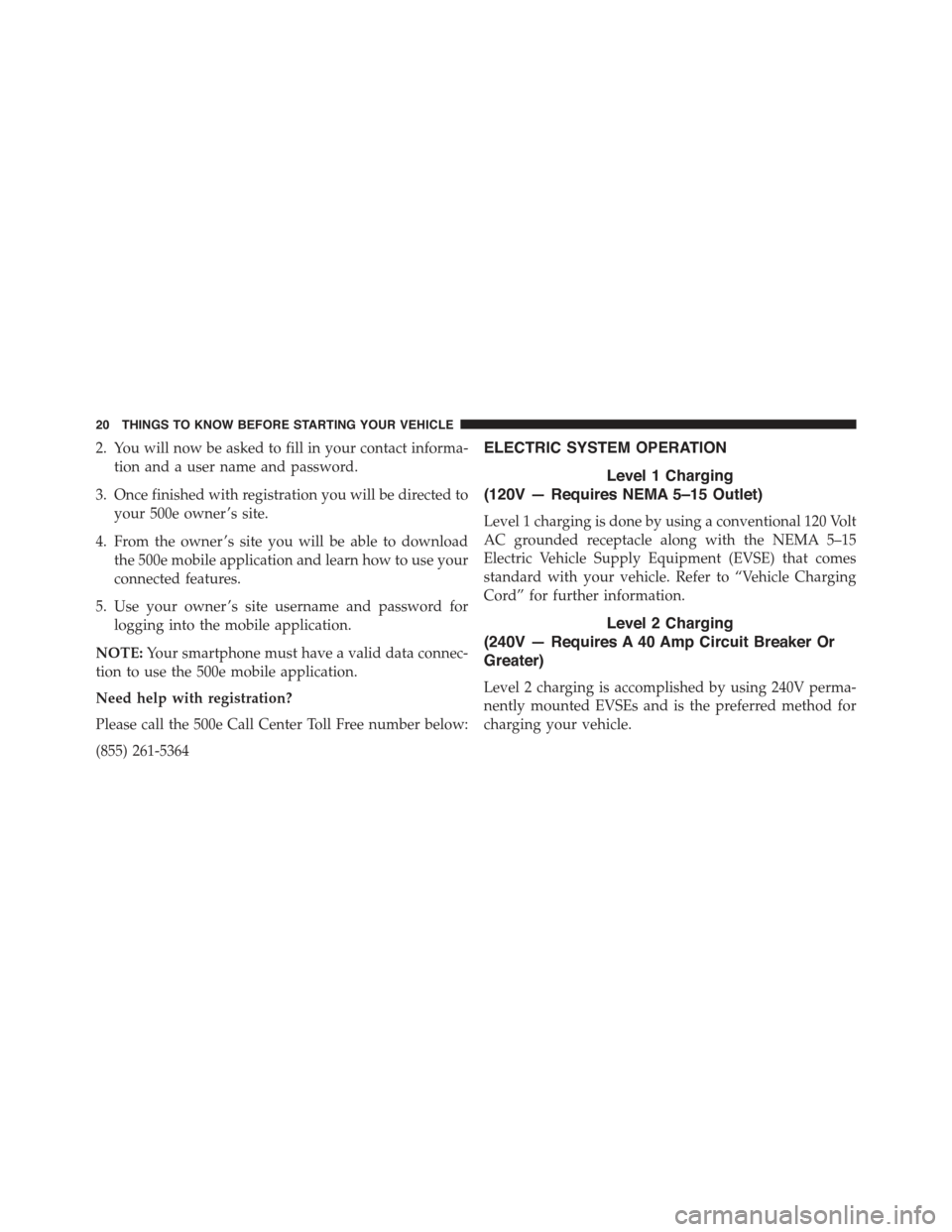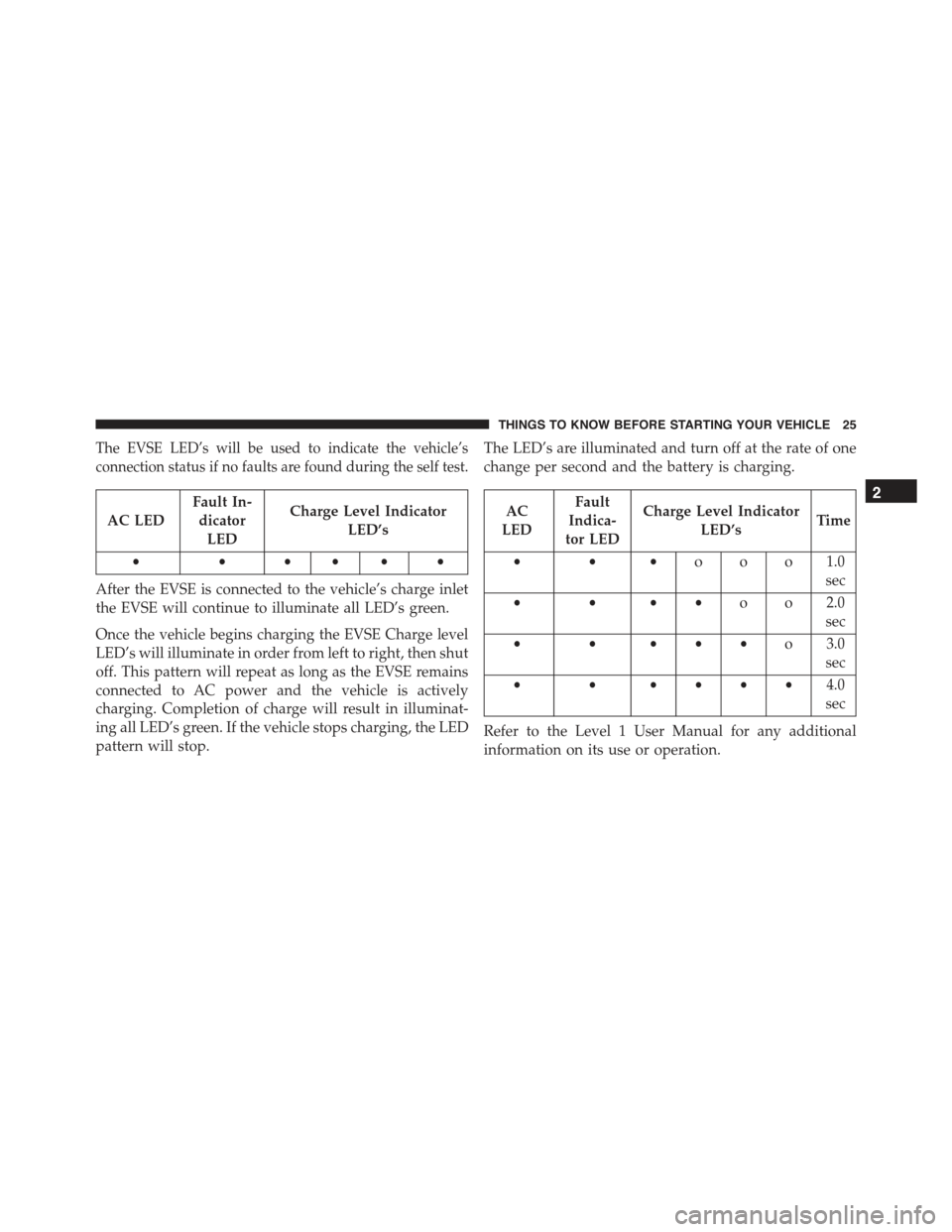charging FIAT 500E 2015 2.G Owners Manual
[x] Cancel search | Manufacturer: FIAT, Model Year: 2015, Model line: 500E, Model: FIAT 500E 2015 2.GPages: 367, PDF Size: 9.42 MB
Page 11 of 367

THINGS TO KNOW BEFORE STARTING YOUR VEHICLE
CONTENTS
!IMPORTANT VEHICLE INFORMATION.......12
▫High Voltage Battery....................12
!500e ELECTRIC VEHICLE FEATURES.........14
▫Audible Pedestrian Warning System.........15
▫Single-Speed Transmission................15
▫Auto Park............................15
▫E-Park..............................15
▫Climate Control (HVAC System)............16
▫Electric Air Conditioning Compressor........16
▫Electric Power Steering..................16
▫Smartphone Features....................17
!ELECTRIC SYSTEM OPERATION............20
▫Level 1 Charging (120V — Requires
NEMA 5–15 Outlet).....................20
▫Level 2 Charging (240V — Requires A 40 Amp
Circuit Breaker Or Greater)...............20
▫Charge Times.........................21
▫Vehicle Charge Cord....................22
▫EVSE Operation And Status Information......23
▫Charging The High Voltage Battery..........26
2
Page 15 of 367

Lithium-ion batteries provide the following benefits:
•Lithium-ion batteries are much lighter than other
types of rechargeable batteries of the same size.
•Lithium-ion batteries hold their charge; they only lose
approximately 3 percent of their charge per month.
•Lithium-ion batteries have no memory, which means
that you do not have to completely discharge them
before recharging, as with some other batteries.
•Lithium-ion batteries can be recharged and discharged
thousands of times.
High Voltage Battery Service Disconnect
The high voltage battery service disconnect is located
under the rear passenger seat lower cushion. If your
vehicle requires, service see your authorized dealer.
WARNING!
Never try to remove the high voltage service discon-
nect. The high voltage service disconnect is used
when your vehicle requires service by a trained
technician at an authorized dealer. Failure to follow
this warning can cause severe burns or electrical
shock that may result in serious injury or death.
Disposal of the High Voltage Battery
Your vehicle’s high voltage battery is designed to last the
life of your vehicle. See your authorized dealer for
information on the disposal of the battery if it should
require replacement.
2
THINGS TO KNOW BEFORE STARTING YOUR VEHICLE 13
Page 19 of 367

Smartphone Features
With the “FIAT Access” smartphone app, you can moni-
tor the state of charge of the high voltage battery or
initiate charging from your phone. You can also turn on
your car ’s climate control system remotely. The smart-
phone app provides the following features:
•Monitor battery charge level
•Display available driving distance
•Check charging status
•Remotely activate vehicle climate control system
•Unlock and lock doors
•Assist with locating your vehicle
•Locate charging stations
•Send a point-of-interest to your vehicle
•Schedule a charge
•View energy consumed
•Notifications for charging and preconditioning events
2
THINGS TO KNOW BEFORE STARTING YOUR VEHICLE 17
Page 22 of 367

2. You will now be asked to fill in your contact informa-
tion and a user name and password.
3. Once finished with registration you will be directed to
your 500e owner ’s site.
4. From the owner ’s site you will be able to download
the 500e mobile application and learn how to use your
connected features.
5. Use your owner ’s site username and password for
logging into the mobile application.
NOTE:Your smartphone must have a valid data connec-
tion to use the 500e mobile application.
Need help with registration?
Please call the 500e Call Center Toll Free number below:
(855) 261-5364
ELECTRIC SYSTEM OPERATION
Level 1 Charging
(120V — Requires NEMA 5–15 Outlet)
Level 1 charging is done by using a conventional 120 Volt
AC grounded receptacle along with the NEMA 5–15
Electric Vehicle Supply Equipment (EVSE) that comes
standard with your vehicle. Refer to “Vehicle Charging
Cord” for further information.
Level 2 Charging
(240V — Requires A 40 Amp Circuit Breaker Or
Greater)
Level 2 charging is accomplished by using 240V perma-
nently mounted EVSEs and is the preferred method for
charging your vehicle.
20 THINGS TO KNOW BEFORE STARTING YOUR VEHICLE
Page 23 of 367

A Level 2 charging station can be installed at your
residence. The Level 2 unit and installation service is
available for purchase at your authorized dealer.
Charge Times
The following factors determine the time it takes to
charge the high voltage battery:
•The high voltage battery’s current state of charge
•What level EVSE is being used (Level 1 – 120V or Level 2
– 240V)
•Ambient temperature
NOTE:
•The charging times are estimates based on a com-
pletely discharged high voltage battery.
•Charging times will vary based on the age, condition,
state of charge and temperature of the high voltage
battery.Level 2 Charging Station
2
THINGS TO KNOW BEFORE STARTING YOUR VEHICLE 21
Page 24 of 367

Type of Charge Estimated Charge Time
Level 1 (120V/15A) Approximately 23 hours
Level 2 (240V/30A) Approximately 4 hours
Vehicle Charge Cord
Your vehicle comes equipped with a standard AC 120V
NEMA 5-15 Electric Vehicle Supply Equipment (EVSE)
also referred to as a charge cord.
The EVSE plugs into any standard AC grounded outlet
and is used to charge the high voltage battery. To access
the charge cord, lift the rear cargo cover and remove the
charging cord from the storage bin.
NOTE:The EVSE charge cord is used for Level 1
charging only.
EVSE Location
22 THINGS TO KNOW BEFORE STARTING YOUR VEHICLE
Page 25 of 367

SAE J1772 Charge Receptacle
Your vehicle uses an industry standard SAE J1772 charge
receptacle (vehicle’s inlet) for both AC Level 1 (120V) and
AC Level 2 (240V) charging.
NOTE:The charge receptacle door locks and unlocks
with the vehicle doors.
EVSE Operation And Status Information
IndicatorDescription
1 — AC Indicator
LED
Green indicates READY
RED Indicates a fault
SAE J1772 Charge Receptacle
EVSE Status Indicators
2
THINGS TO KNOW BEFORE STARTING YOUR VEHICLE 23
Page 26 of 367

IndicatorDescription
2 — Fault Indicator
LED
Green indicates READY
RED indicates a fault
3 — Charge Level
Indicator LED’s
All ON indicates system ready
and not charging
LED’s turning on and off in
sequence indicates vehicle
charging
When the EVSE is first plugged in it will go through an
initialization and self test. For the first three seconds after
plugging in your EVSE all the LED’s will remain off.
After approximately three seconds the EVSE performs an
internal self test and Ground Continuity Test. This pro-
cess takes approximately six seconds.
During the internal self test the unit turns on one Charge
Level Indicator LED every 1.5 seconds until all the
Charge Level Indicator LED’s are illuminated.
AC
LED
Fault
Indica-
tor LED
Charge Level Indicator
LED’sTime
•••ooo1.5
sec
••••o o 3.0
sec
•••••o 4.5
sec
••••••6.0
sec
If the self test is successful the AC LED, the Fault
Indicator LED and the four Charge Level LED’s will turn
solid green.
24 THINGS TO KNOW BEFORE STARTING YOUR VEHICLE
Page 27 of 367

The EVSE LED’s will be used to indicate the vehicle’s
connection status if no faults are found during the self test.
AC LED
Fault In-
dicator
LED
Charge Level Indicator
LED’s
••••••
After the EVSE is connected to the vehicle’s charge inlet
the EVSE will continue to illuminate all LED’s green.
Once the vehicle begins charging the EVSE Charge level
LED’s will illuminate in order from left to right, then shut
off. This pattern will repeat as long as the EVSE remains
connected to AC power and the vehicle is actively
charging. Completion of charge will result in illuminat-
ing all LED’s green. If the vehicle stops charging, the LED
pattern will stop.
The LED’s are illuminated and turn off at the rate of one
change per second and the battery is charging.
AC
LED
Fault
Indica-
tor LED
Charge Level Indicator
LED’sTime
•••ooo1.0
sec
••••o o 2.0
sec
•••••o 3.0
sec
••••••4.0
sec
Refer to the Level 1 User Manual for any additional
information on its use or operation.
2
THINGS TO KNOW BEFORE STARTING YOUR VEHICLE 25
Page 28 of 367

Charging The High Voltage Battery
1. Put the vehicle in PARK.
2. Turn the ignition to the OFF position.
3. Remove the Level 1 EVSE from its storage bin by
lifting the rear cargo cover.
4. Uncoil the entire length of the EVSE (charge cord).
5. Plug the EVSE into a standard 120V AC outlet that is
properly grounded. It is recommended that the EVSE
is connected to an AC outlet on a circuit which is not
electrically loaded by other devices. Extension cords
may not be used.
NOTE:All of the EVSE LED’s illuminate green.
6. Open the charge receptacle door.
NOTE:The charge receptacle door is locked whenever
the vehicle is locked. Unlock the doors to unlock the
charge receptacle door for charging.
7. Plug the EVSE into the charge receptacle. Push the
EVSE in firmly until it is completely engaged (if not
completely engaged the vehicle may not charge).
EVSE Location
26 THINGS TO KNOW BEFORE STARTING YOUR VEHICLE